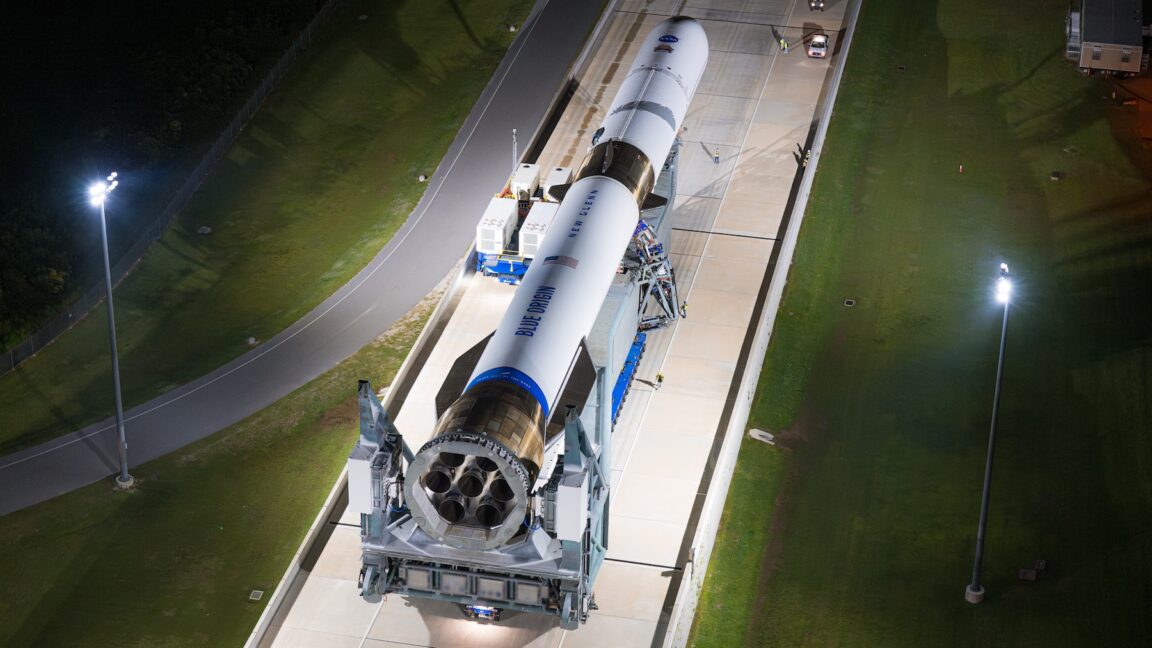Science
NASA’s ESCAPADE Mission Launches with Innovative Trajectory to Mars

NASA’s ESCAPADE mission is set to launch on November 5, 2023, aboard Blue Origin’s New Glenn rocket from Cape Canaveral, Florida. This mission, aimed at exploring Mars, faced potential delays due to challenges with the rocket’s readiness, but innovative trajectory planning has paved the way for its successful departure.
ESCAPADE, which stands for Escape and Plasma Acceleration and Dynamics Explorers, consists of two identical spacecraft. Unlike traditional missions that follow a direct path to Mars, the ESCAPADE mission will employ a unique loiter orbit around Earth. This trajectory allows for a more flexible launch schedule, enabling the spacecraft to wait until Mars aligns correctly with Earth, anticipated in November 2024.
Rob Lillis, the mission’s principal investigator from the University of California, Berkeley, explained, “ESCAPADE is pursuing a very unusual trajectory in getting to Mars.” This decision marks a significant shift from the original plan, which aimed for a direct route taking approximately six to nine months. Instead, the spacecraft will begin its journey when Mars is over 220 million miles away, necessitating an extended transit.
The importance of timing in planetary exploration cannot be overstated. The previous launch window for Mars occurred in 2022, with the next opportunity not available until late 2026. NASA’s decision to use the New Glenn rocket, despite its relatively recent development and the associated risks, reflects a strategic approach to cost and mission objectives. The agency secured a launch contract with Blue Origin for roughly $20 million, considerably less than other options available for the mission.
Blue Origin’s New Glenn rocket, towering at 321 feet (98 meters), is designed to deliver significant payloads to space. While capable of transporting multiple tons, it will only carry around a ton for this mission. NASA’s investment in this innovative approach is tempered by the understanding that the rocket has not yet been fully certified, having completed its first test flight successfully in January 2023.
If all goes according to plan, the New Glenn rocket will launch during an 88-minute window starting at 14:45 EST (19:45 UTC). The launch team, headed by launch director Megan Lewis, will initiate the countdown, filling the rocket with super-cold liquid methane and liquid oxygen about four and a half hours before liftoff. This meticulous preparation is critical, as the mission’s success hinges on the reliability of the rocket’s systems.
Once airborne, the New Glenn rocket will accelerate past the speed of sound within the first minute. After shedding its first stage, the rocket will ignite its twin BE-3U engines to propel the ESCAPADE satellites toward their final destination. The mission will take a novel path, characterized by a kidney bean-shaped trajectory, allowing it to remain in a gravitationally stable orbit known as the L2 Lagrange point until the optimal moment to head for Mars.
Despite the risks associated with this unconventional approach, this trajectory is designed to demonstrate a flexible and innovative method for future interplanetary missions. The spacecraft will be exposed to increased radiation and will consume more fuel than initially planned, but this trade-off could facilitate the launch of multiple missions to Mars in the future.
“We believe that the risk for the mission is acceptable,” stated Richard French, vice president of business development and strategy at Rocket Lab, which built the satellites. The ESCAPADE mission ultimately aims to enhance our understanding of how Mars interacts with solar wind, providing valuable insights for future exploration.
As the countdown proceeds, Blue Origin is optimistic about landing the New Glenn booster after its flight, building on lessons learned from its previous inaugural launch, which ended in a crash due to engine restart issues. Blue Origin has implemented changes to increase the likelihood of a successful recovery.
Laura Maginnis, Blue Origin’s vice president of New Glenn mission management, emphasized the dual objectives of the mission: “Our No. 1 objective is to deliver ESCAPADE safely and successfully on its way to L2, and then eventually on to Mars.”
With the launch on the horizon, the excitement surrounding the ESCAPADE mission reflects not only NASA’s commitment to advancing space exploration but also the innovative spirit driving modern aerospace endeavors.
-

 Science3 months ago
Science3 months agoToyoake City Proposes Daily Two-Hour Smartphone Use Limit
-

 Health3 months ago
Health3 months agoB.C. Review Reveals Urgent Need for Rare-Disease Drug Reforms
-

 Top Stories3 months ago
Top Stories3 months agoPedestrian Fatally Injured in Esquimalt Collision on August 14
-

 Technology3 months ago
Technology3 months agoDark Adventure Game “Bye Sweet Carole” Set for October Release
-

 World3 months ago
World3 months agoJimmy Lai’s Defense Challenges Charges Under National Security Law
-

 Lifestyle3 months ago
Lifestyle3 months agoVictoria’s Pop-Up Shop Shines Light on B.C.’s Wolf Cull
-

 Technology3 months ago
Technology3 months agoKonami Revives Iconic Metal Gear Solid Delta Ahead of Release
-

 Technology3 months ago
Technology3 months agoApple Expands Self-Service Repair Program to Canada
-

 Technology3 months ago
Technology3 months agoSnapmaker U1 Color 3D Printer Redefines Speed and Sustainability
-

 Technology3 months ago
Technology3 months agoAION Folding Knife: Redefining EDC Design with Premium Materials
-

 Technology3 months ago
Technology3 months agoSolve Today’s Wordle Challenge: Hints and Answer for August 19
-

 Business3 months ago
Business3 months agoGordon Murray Automotive Unveils S1 LM and Le Mans GTR at Monterey









